[Editor’s Note: This article is written by guest contributor Susie Stephen, a former Division I collegiate runner turned trail runner and yoga teacher.]
Yoga is a ‘go-to’ for many trail runners, as a form of cross, or complimentary training. In Joe Uhan’s recent article about yoga in terms of performance flexibility, the benefits of yoga for runners were discussed. Joe outlined a number of yoga poses and types of classes that are ideal for runners. In this article, we dive a little deeper and look at how two key components of trail and ultrarunning–core strength and recovery–can be enhanced with the use of yoga-centred techniques.
Yoga for Core Strength
Addressing the area of core strength first, let’s turn to why? Why should trail and ultrarunners use yoga to develop core strength? Practicing yoga ‘asana’–the poses–is the physical aspect of yoga conditioning that relies solely on body weight. To move and shift our body in and out of various yoga poses naturally develops the core strength that is also essential to running. And when I say ‘core’, it is the stabilising muscles of the trunk that I’m referring to, rather than simply the traditional ‘six-pack’ or rectus abdominus muscles. The core set also includes: the obliques, the transverse abdominus, the adductors, the quadratus lumborum, and the psoas major. These stabilising muscles are essential to trail and ultrarunning to counter the effects of challenging terrain, fatigue, and hours on the feet. The key to really using these muscles in a yoga pose is to engage them, switch them on, or ‘fire them’–to get them working actively rather than passively. Planks are a great way to build core strength and Chaturanga, as demonstrated by Joe in his post, is a part of every Vinyasa flow class. There are a wide number of variations you can make with plank pose to build strength across the whole spectrum of the core.
Tree Pose
Tree Pose, Vrkasana, is also a handy and very simple yoga pose that works the whole core from top to bottom, front to back, and side to side. And the great thing about tree pose (and all yoga) is that it is very accessible–you don’t need a yoga mat and it can be practiced before, straight after, or even during a run.
1. To begin, stand tall with your feet together on an even surface. Take a moment to focus on the core of your body.
2. Shift weight into your left foot, and raise your right foot off ground–using core muscles to help you balance. Take the right knee out to the side, opening the hip. Using your right hand, place the sole of the right foot against the inner left leg–above or below the knee–pressing the foot into the inner leg.
3. Bring hands to the center of your chest in a prayer position. Look ahead and find a point to focus on (in yoga terms, a drishti point). Engage the muscles of the standing leg, especially the quad, and keep the core switched on.
4a. If you feel steady, raise your hands up overhead with as you inhale.
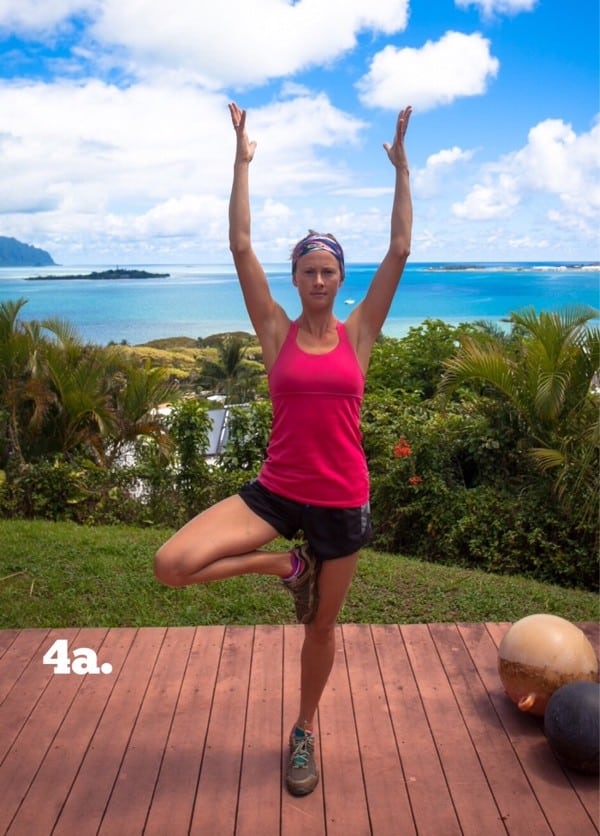
Photo: Jesse Stephen
4b. Next, separate your hands and start to ‘sway’ over to the left as you exhale–stretching up as you move, staying grounded through the standing leg and hips. Keep the movement slow and deliberate.
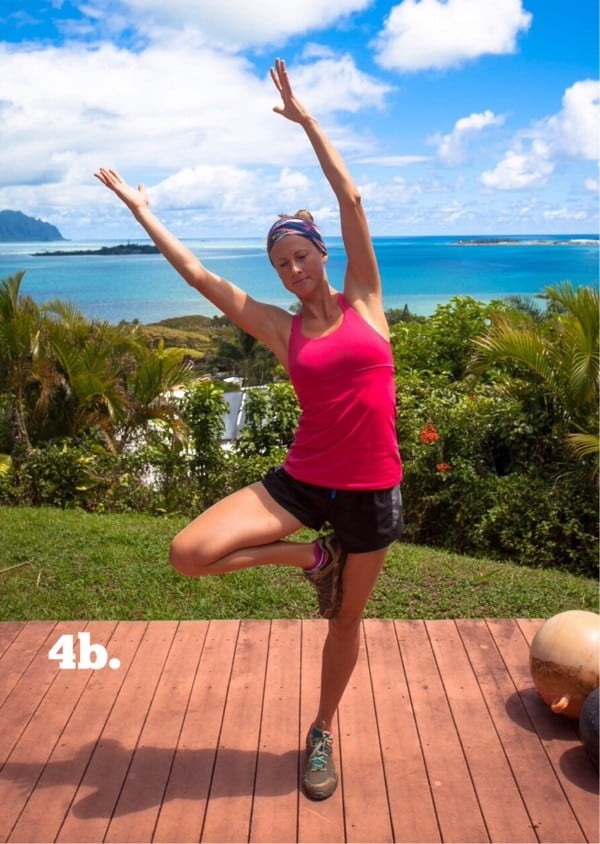
Photo: Jesse Stephen
4c. Move your arms back to center with the next inhale, and then over to the right with an exhale, repeating the same process–becoming aware of how the core, legs, ankles, and feet help you to stabilise.

Photo: Jesse Stephen
5. Bring your arms back to center and lower them down to the sides of the body. Release your foot, give your arms and legs a small shake out, and then repeat on the second side.
6. Runners with a strong core and legs may find this tree-pose sequence very simple. If that is the case, take the exercise a step further and practice with your eyes closed. This builds greater proprioception and strength through the sole of the foot and ankle as you take away the visual input–an effective way to increase lower-leg strength for agility over gnarly roots.
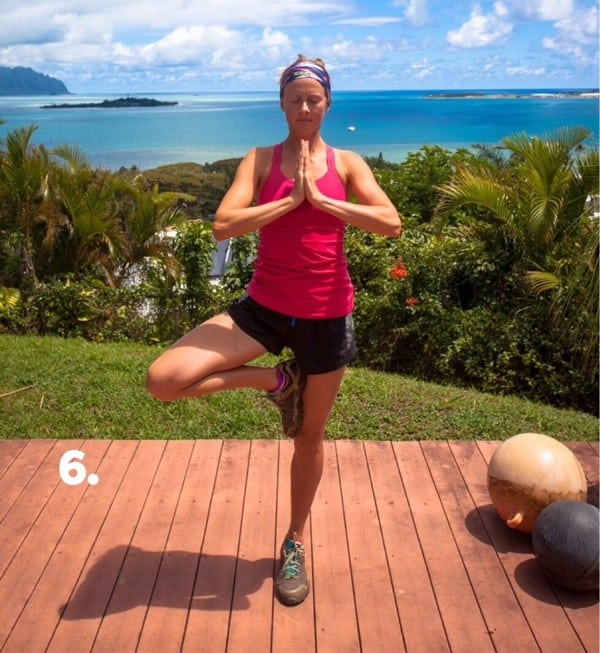
Photo: Jesse Stephen
7. If, on the other hand, you need a little extra help with balancing, place the foot in a lower position against the standing leg, or even just place the foot against the opposite ankle. Stand next to or lean against a wall for even more support.
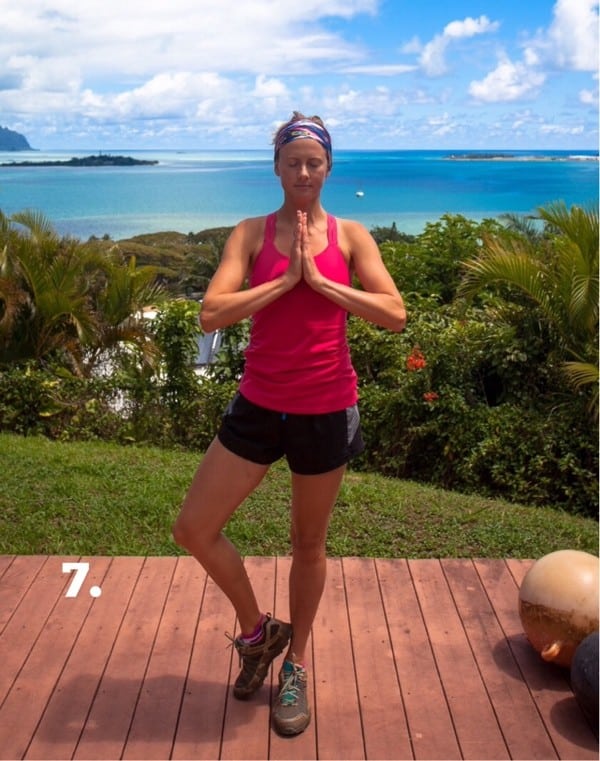
Photo: Jesse Stephen
To refer back to the yoga term Drishti for a moment, it is useful to consider what it means. Drishti translates as a point of focus for the eyes but it also refers to a settling place for the mind. Drishti points can move and change, just as we move and change, and make sense when applied to trail running, as explained by Runner’s World and Yoga Journal contributor Sage Rountree said, “Your body goes where your gaze goes. You need to develop awareness of your drishti, or gazing point, to choose the right line over trails.” Most trail runners have a built-in ‘Drishti antenna’ to find a path across technical sections of trail. But through yoga, we can work on perfecting the art of Drishti, and hone strength and balancing skills in poses such as Vrkasana without having to leave the house.
Yoga for Recovery
Legs Up The Wall Pose
But what about yoga for recovery? What is the best type of yoga practice for the end of the day, when we are all done and dusted with our miles on the trails, and core work? There are a number of yoga poses that are great for recuperating and whether that is after a race, a long day on the trails, or maybe on a scheduled day off, all runners need some recovery time.
Arguably the most beneficial recovery yoga pose for runners is Legs Up The Wall Pose, Viparita Karani. A simple inversion of the legs up against a wall, or on to a chair, bed, or even a tree, this pose uses gravity to help relieve pressure on tired feet and joints. It also allows accumulated fluids to dissipate, and can relieve tension in other parts of the body. Ancient yogis termed Legs Up The Wall as life extending, maybe another great reason to mix yoga with running.
1. To begin sit sideways, close to your chosen support and bring one hip up against it. Sit back on your hands and begin to pivot around so that your legs swing up against the support, bum now facing the support. At this point listen to your hamstrings! If they are tight you may need to adjust the distance between your body and the wall/chair/tree. Find your comfortable distance, and lie down on the surface behind you. From here, extend the legs up the wall and allow the arms to relax by the side of the body.
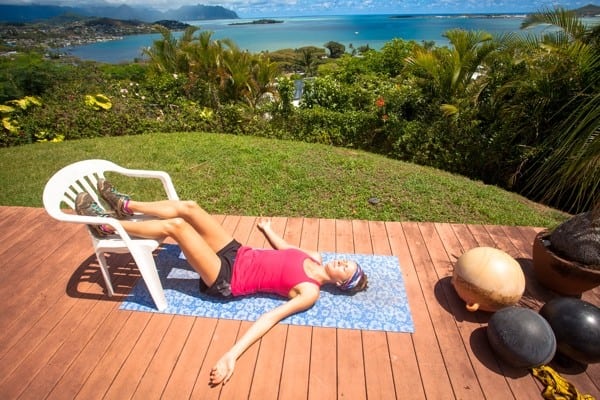
Photo: Jesse Stephen
2. Once your legs are up against the wall/chosen support, there are a number of variations you can do with this pose to make it more comfortable:
- a. Allow the legs to move out to make a V shape, which stretches the groins and inner thighs.
- b. Baddha Konasana legs. Bend the knees, draw them down the wall and move them out to the side, placing the soles of the feet together. Keep the arms down by the side of the body or take them overhead to relax against the ground.
- c. If you’re at home, and have a yoga strap (or a scarf or belt handy), make a loop and place it around your thighs just above the knees. Let the legs relax against the strap for extra support.
- d. A further step would be to ask someone to place a bag of rice or beans across the soles of your feet. This gentle, extra pressure helps to sink the hips closer to the floor, releasing tension in the lower back.

Photo: Jesse Stephen
3. If you don’t have a supporting wall or something similar nearby, you can still gain the benefits of inverting the legs by using a rolled up towel or a yoga block and placing it underneath your hips. This small lift should allow you to raise the legs up but keep the knees slightly bent if the hamstrings feel tight.
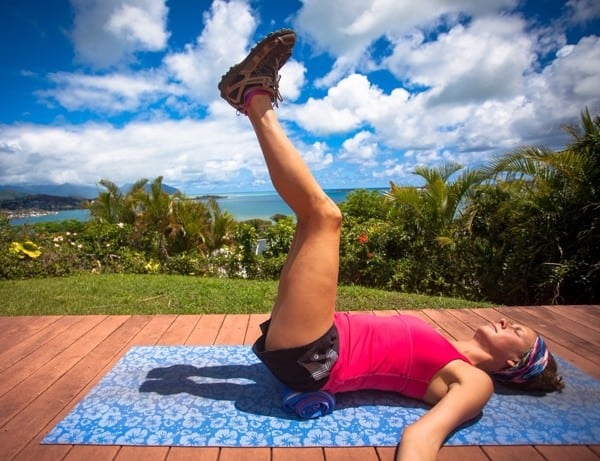
Photo: Jesse Stephen
4. Stay in Viparita Karani for as little as five minutes or for as long as 15 to 20 minutes. If you sense any tingling in the toes, just bend the knees and lower the feet down closer to the body. To move out of the pose, bend the knees to the chest and slowly roll over on to your right hand side, lifting the head up last as you move to sitting. Stand up slowly after being on the ground for a while.
Personally I use Legs Up The Wall all the time–not only for mini-recovery breaks after training runs slotted into busy days, but I have also found it to be a critical component in the recovery from (and subsequent prevention of) Piriformis Syndrome. After a consultation with a physiotherapist, who suggested I do less foam rolling over the inflamed area (which was only worsening the issue), I turned to restorative yoga, and especially Legs Up The Wall. The pose allows for gentle mobility work without the excess stimulation of intense stretching or foam rolling. Deeper relaxation of the piriformis freed the impingement on the sciatic nerve, et voila–no more hamstring or lower-leg issues that had all been connected to that one muscle!
Corpse Pose
A second recovery pose that may have already sprung to mind is Savasana, or Corpse Pose, which is typically practiced at the end of most yoga classes. The beauty of corpse lies in its name–you simply lie as still as a dead body for as little as five minutes (but 10 to 15 minutes would be even better), giving the body and mind a chance to come to a complete stop, but yet without switching off or falling asleep! Corpse Pose gives the parasympathetic nervous system a chance to kick in, which is when the recovery magic happens. The parasympathetic nervous system is the alternative to the flight or fight response of the body. This ‘flight or fight’ is a common, and often default modus operandi in the modern world. Giving the body and mind a break from ‘fighting’ provides every single cell the full opportunity to work without duress. And yes, you can also do this by taking a power nap but the difference is that in Savasana you are consciously connected to the process, and so in a sense, it’s a bonus move, you are the driver rather than just the passenger.
Erin Taylor, Chief Ease Officer of Jasyoga based in Seattle, Washington and London, England has these words of advice about the necessity of recovery:
“In running and in life, recovery is just as important and equally productive as everything else that you do. It’s all about balance. If you don’t match the time you go hard with equal time spent resting easy, you’ll increase your injury risk and reduce your chances of meeting your potential. When practiced in a way that is optimized for the demands of running, yoga alleviates run-induced imbalances and calms the nervous system. It’s not just about stretching your muscles—it’s about reducing any stress in the body and the mind so that healing can occur and everything can function optimally the next time you’re out on the trails.”
More Thoughts on Combining Yoga and Running
Running and yoga are both simple and free ways of staying connected to what we all enjoy–being outside and hitting the trails, for as long as possible. There are multiple applications of yoga-based exercises that runners can turn to for assistance at any time. And whether it is to develop better core strength or to regroup at the end after an epic day in a canyon, or to improve flexibility as we read in Joe’s article, and there is usually something for everyone.
If you are new to yoga, and lucky enough to live in a town with a yoga studio, I highly recommend going along to a beginner class, or maybe a yoga-for-athletes class if they have one! Chat with the teacher before the class starts, and let them know you are a runner since they will be able to recommend what to do, and more importantly what not to do. The last thing any yogi runner wants is a tweaked muscle after an overzealous yoga practice.
If a yoga studio is not handy, there are numerous online resources, with live-streamed classes. Websites such as YogaGlo or YogaVibes have classes designed especially for athletes. Teachers such as Sage Rountree and Tiffany Cruikshank have both worked with runners, and understand an endurance athlete’s body. Runner’s World also has an online Yoga Center, with video sessions led by running yogi Rebecca Pacheco. And I also have a short yoga-for-runners video you can try online.
Whenever you decide to practice yoga–it is always best to go in with warm muscles, or do a short warm up first (something dynamic like a brisk walk, a bike ride to the studio, short jog, or slow sun salutations). Have fun and take it easy–practice and patience go along way in yoga, just as they do with running.
Call for Comments (from Meghan)
- Do you practice yoga for the purpose of gaining core strength or recovering from your intense running and the rest of life? If so, can you describe your practice?
- Do you practice Tree Pose, Legs Up the Wall Pose, or Corpse Pose? If so, what are the benefits of these poses for you?
